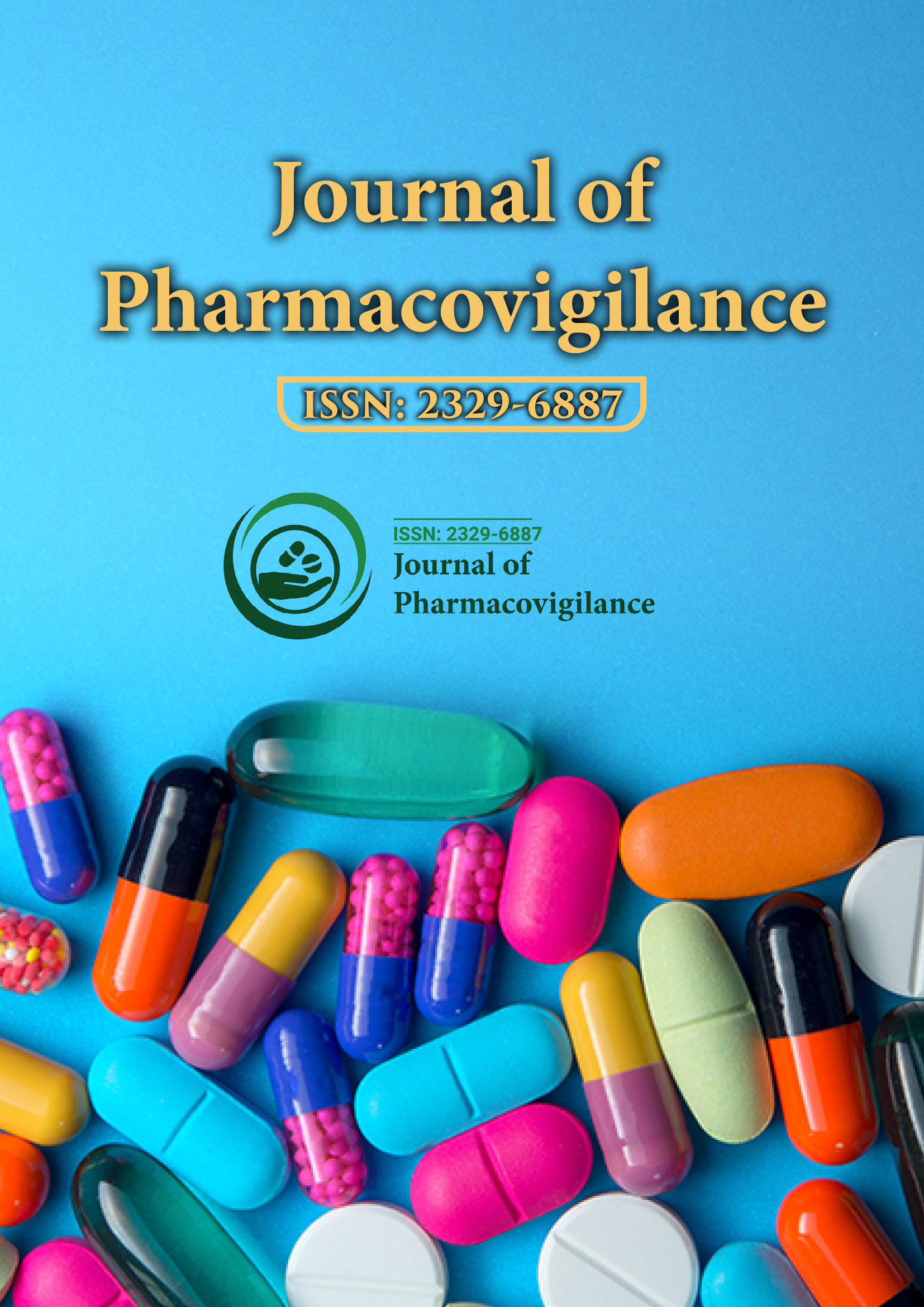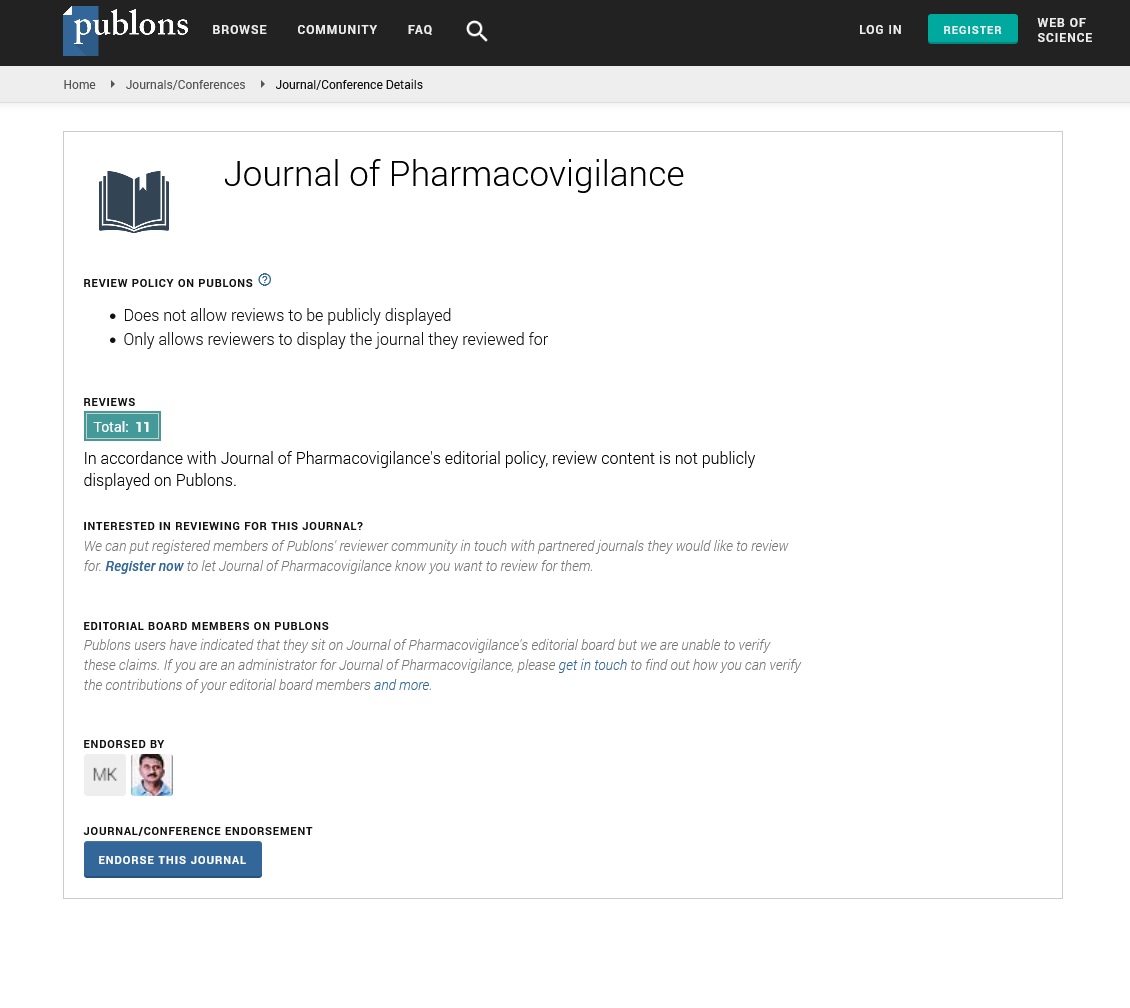Indexed In
- Open J Gate
- JournalTOCs
- The Global Impact Factor (GIF)
- RefSeek
- Hamdard University
- EBSCO A-Z
- OCLC- WorldCat
- Publons
- Euro Pub
- Google Scholar
Useful Links
Share This Page
Journal Flyer

Open Access Journals
- Agri and Aquaculture
- Biochemistry
- Bioinformatics & Systems Biology
- Business & Management
- Chemistry
- Clinical Sciences
- Engineering
- Food & Nutrition
- General Science
- Genetics & Molecular Biology
- Immunology & Microbiology
- Medical Sciences
- Neuroscience & Psychology
- Nursing & Health Care
- Pharmaceutical Sciences
Perspective - (2021) Volume 9, Issue 6
An Overview on Pharmacoepidemiology
Shaik Moulali*Received: 04-Jun-2021 Published: 25-Jun-2021, DOI: 10.35248-2329-6887.21.9.320
Pharmacoepidemiology aims to complete the evaluation of drugs made before approval, by providing reliable information concerning effectiveness, safety and utilization of medicines in realistic conditions. The goal may be only descriptive or aetiological. In the latter, the conclusions from observational studies can be jeopardized by systematic errors and cannot achieve the robustness of experimental designs. According to directionality, three main types of studies can be identified: cross-sectional, prospective and retrospective. Prospective and retrospective studies can be based on a single group (descriptive studies) or include a reference group (comparative or aetiologic studies).
Pharmacoepidemiology is the investigation of the utilizations and impacts of medications in clear cut populations. To achieve this examination, pharmacoepidemiology gets from both pharmacology and the study of disease transmission. Along these lines, pharmacoepidemiology is the scaffold between both pharmacology and the study of disease transmission. Pharmacology is the investigation of the impact of medications and clinical pharmacology is the investigation of impact of medications on clinical people. Part of the assignment of clinical pharmacology is to give a danger advantage appraisal by impacts of medications in patients: doing the examinations expected to give a gauge of the likelihood of helpful consequences for populaces, or then again surveying the likelihood of unfavorable impacts on populaces [1]
Different boundaries identifying with drug use may profit epidemiological philosophy. Pharmacoepidemiology then, at that point can likewise be characterized as the straightforward utilization of epidemiological strategies through pharmacological treatment of conditions to more readily comprehend the conditions to be treated. Epidemiology is the investigation of the conveyance and determinants of illnesses and other wellbeing states in populaces. Epidemiological examinations can be partitioned into two principle types:
Clear the study of disease transmission depicts sickness and additionally openness and may comprise of computing rates, e.g., frequency and pervasiveness.
Such illustrative examinations don't as of now use wellbeing control gatherings and can just produce theories, yet not test them. Investigations of medication use would by and large fall under unmistakable examinations.
Scientific the study of disease transmission incorporates two kinds of studies: observational investigations, for example, case-control and partner examines, and test contemplates which incorporate clinical preliminaries or randomized clinical preliminaries. The scientific investigations contrast an uncovered gathering and a benchmark group and generally planned as theory testing by considers.
Pharmacoepidemiology profits by the procedure created in everyday the study of disease transmission and may additionally foster them for utilizations of technique interesting to necessities of pharmacoepidemiology. There are likewise a few regions that are out and out novel to pharmacoepidemiology, e.g., pharmacovigilance. Pharmacovigilance is a kind of ceaseless observing of undesirable impacts and other wellbeing related parts of medications that are now positioned in current developing coordinating business sectors. By and by, pharmacovigilance alludes solely to unconstrained revealing frameworks which permit medical care experts and others to report antagonistic medication responses to the focal office. The focal organization consolidates reports from numerous sources to create a more useful profile for drug items than should be possible dependent on reports from less medical care experts [2].
With the expanding cost to find and foster another medication, drug use will keep on developing. With regards to restricted medical services spending plans, pharmacoeconomic contemplations are essential and can extraordinarily work with ideal utilization of restricted assets. Applying pharmacoeconomic assessment, the worth of one drug medication or medication treatment to another might measure up. A pharmacoeconomic study assesses the expense (communicated in financial terms) and impacts (communicated as far as money related worth, viability or upgraded personal satisfaction) of a drug product. It includes in recognizing, estimating, and looking at the costs, risks, and advantages of projects, administrations, or treatments and figuring out which creates the best wellbeing result for the assets contributed. It endeavors to coordinate pertinent data both on adequacy and cost with the goal that clinicians, patients, and other chiefs can settle on significant treatment decisions. From a more extensive perspective, it very well may be characterized as the portrayal and investigation of cost and results of drugs and drug administrations and their effect on people, medical care frameworks, and society [3].
All strategies for pharmacoeconomic assessment share the normal component of contrasting sources of info (cost) with results (benefits) coming about because of medication intercession. The expense of medication treatment relates not exclusively to the cost of the medication yet in addition incorporates immediate and roundabout expenses. Direct expenses incorporate expenses of staff and capital. Aberrant expenses may incorporate loss of income, loss of usefulness and cost of movement to medical clinic. A significant number of these expenses are hard to quantify, as are theoretical expenses for torment or other trouble a patient may endure. Advantages may likewise be estimated as far as clinical results or humanistic result utility units like personal satisfaction . The Quality Adjusted Life Year (QALY) is a proportion of wellbeing result which incorporates quality and amount of life. This joins evaluation of actual work like level of portability and psychosocial results like uneasiness and capacity to adapt [4].
Conclusion
Clinical assessment of medications before endorsement depends on the trial plan of clinical preliminary with randomization of medication openness. Shockingly, finishes of clinical preliminaries are essentially restricted to patients included into the preliminaries. It is accordingly important to analyze these trial information coming from clinical preliminaries with the genuine utilization of medications in clinical practice. Pharmacoepidemiology is the investigation of connections among medications and human populaces, examining, in genuine states of life, advantages, dangers and utilization of medications. Pharmacoepidemiology applies to drugs the techniques as well as thinking of both pharmacology and the study of disease transmission. The advancement of pharmacoepidemiology ought to improve the "sane medication use".
REFERENCES
- D'Agostino R.B., Jr (1998) Tutorial in biostatistics: Propensity score methods for bias reduction in the comparison of a treatment to a non-randomized control group. Stat Med 17: 2265–2281
- Mussen F., Salek S., Walker S. (2009) A Future Framework for Benefit–Risk Appraisal of Medicines, Benefit–Risk Appraisal of Medicines: a Systematic Approach to Decision-Making, 1st, John Wiley & Sons: Chichester
- Suissa S. (2000) Novel approaches to pharmacoepidemiology study design and statisticial analysis. In: Strom B. (ed.), Pharmacoepidemiology, 3rd, John Wiley & Sons: Chichester
- Vandenbroucke J.P. (2004a) Benefits and harms of drug treatments. BMJ 329: 2–3
Citation: Shaik M (2021) An Overview on Pharmacoepidemiology. J. Pharamacovigil. 9:320. doi-10.35248-2329-6887.21.9.320.
Copyright: ©2021 Shaik M. This is an open-access article distributed under the terms of the Creative Commons Attribution License, which permits unrestricted use, distribution, and reproduction in any medium, provided the original author and source are credited.

